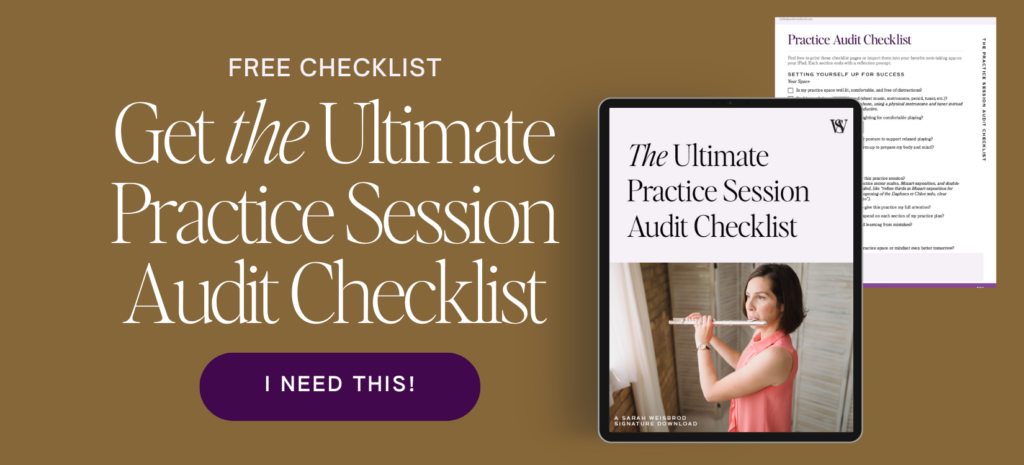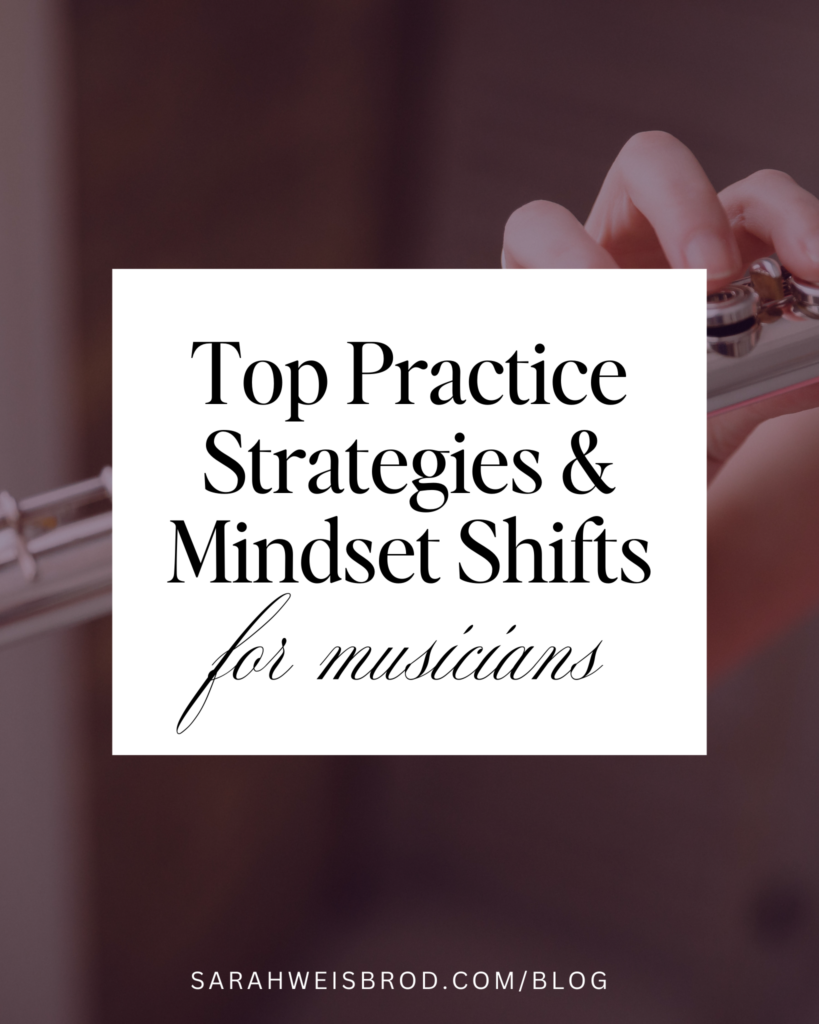So, you want 2025 to be the year you see exponential growth as a musician?
Well, that means it’s time to transform your approach to practice.
And to do that, you need to make sure you’re using effective practice strategies so you can perform with unshakeable confidence.
A successful performance? Yes, please!
Here’s the thing…
Once I changed the way I practiced, I had better control of my nerves. I didn’t worry about what others thought about my playing, and I felt in command of the difficult passages that once plagued me.
In this post, you’ll learn small changes you can make in your practice that will help you create enjoyable and productive practice sessions.
Let’s dive in!
If you ever feel like you don’t know what to practice and just play whatever’s on your stand…
⬇️⬇️⬇️ Get your FREE copy of the Practice Audit Checklist. ⬇️⬇️⬇️

Key Mindset Shifts
Before we get into the 5 elements to create an effective practice session, let’s cover a few mindset shifts I want you to make in your practice.
Practice can be overwhelming—what to practice? How to practice? For how long? What if I’m busy and don’t have a lot of time?
But practicing is about the process of evolution. It’s about becoming a better artist, musician, and ultimately a better person.
And I get it…
Practicing can also be intimidating. With so many amazing musicians sharing their playing on social media, it’s easy to feel like everything has to be perfect.
(^^^psst…that recording you heard on Instagram? It was probably done in several takes.)
So here’s what I want you to keep in mind while you practice, whether you’re a beginner, adult amateur, or professional musician:
- It’s not about being perfect. Practice is about trying to find the best way to execute the notes on the page. It’s okay to try something because if it doesn’t work, you can try something else.
- It’s a marathon, not a sprint. Think of each practice session as a stepping stone in achieving your large goal. Want to learn that super difficult piece that’s at 160 BPM? Know that you don’t have to play it at tempo right away. Slowly work your way there.
- You’re improving even if it doesn’t feel like it. When you start to really hone in on your playing, you become hyper-aware of your tone and technique. You feel like you’re getting worse even though you’re getting better. I call this the Tolerance of Inexactitude. The better you get, the smaller your tolerance for inexactness (I don’t like the word “error”).
Implementing these mindset shifts will help set you up for success.
Okay, now onto the 5 elements of an effective practice session.
1. Create a Practice Plan Before Each Session
One of the questions I often get asked is how to figure out what to practice—because it’s easy to put your instrument together and just practice *whatever* is on your stand.
But not having a practice plan and just winging things means that you’ll likely:
- Not work on what you set out to accomplish in the first place.
- Spend too much time on one thing.
- Get frustrated because you’re not spending time on what truly needs work (psst…it’s the thing you really DON”T want to practice)
Your practice plan doesn’t need to be complex. Start by making a list of what you want to work on before you put your instrument together.
Your plan can be as general as practice etude #1, practice minor scales, and review Mendelssohn.
Or it can be more detailed, such as
- review measures 45-55 in Mozart Concerto for rhythmic accuracy
- work on the opening run in the Daphnes and Chloe solo
- increase tempo in the Mendelssohn
If you’ve never made a practice plan, this is a great way to start. And, if you’re looking for a more detailed practice planning guide, check out this blog post. It’s an oldie but a goodie.
2. Make Objective Observations
One of the best ways you can make progress quickly is by being objective in the way you assess your practice. Objective observations are nonjudgemental. You’re simply evaluating how things went and what can be done to improve. You’re taking the emotions out of the process of practicing. This is different than subjective observations, which are personal and often judgmental.
To use objective observations in your practicing, ask yourself the following after a run-through of a passage:
- What went right/what went wrong?
- Did you play/sing the correct notes? If you missed some, which did you miss?
- Did you maintain a consistent tempo?
- Were your rhythms accurate?
If you’re unsure about how you played, record yourself. Just remember to listen back with open, nonjudgmental ears.
3. Use Positive Self-Talk
Using positive self-talk goes hand-in-hand with making objective observations because your subconscious believes what you tell it to believe. If you constantly beat yourself up and say things like “I suck,” “this sucks,” or “I’ll never be able to play this”…. Well, that’s what your brain will believe.
Being a musician is highly personal. After all, we are artists, and what we create is an output of our inner creativity. So, it’s so easy for us to be hard on ourselves.
If you’ve ever found yourself using language like:
- “I can’t.”
- “This sucks.”
- “I’ll never win that audition.”
- “Why am I even doing this.”
I want to encourage you to shift the way you speak to yourself in practice sessions. If you find yourself saying “I can’t” or “This sucks.” go back to #2 and try to make objective observations. Are your tongue and fingers coordinated? Are you rushing?
When you take the emotional YOU out of the equation, then you’re simply assessing your work at a binary level: did it work/did it not work? And that will help you get more done in less time.
4. Have a Variety of Solutions to Troubleshoot Challenging Passages
Quite often, the #1 cause of frustration during a practice session stems from not being able to play something. It’s important to have a variety of tools you can use to solve a technical problem. Because if you only have one way to work out a problem and it’s not working, well… you’re kinda stuck.
This is one thing I work on with my private students and with my students inside The Practice Code for Musicians. When you build a practice toolkit that gives you 10 options for solving a problem, you’ll be able to thrive.
From a technical standpoint, when you practice a challenging passage in a variety of ways, you’re helping your brain map the correct execution plan the first time. This means you’re minimizing the possibility of a mistake when it’s go-time.
5. Make Sure Your Playing Tells a Story
I’ll be honest, there are some things an audition panel can’t ignore: pitch, rhythm, and consistent tempo. But, when everyone gets those things right, then it’s time to look at what additional things a musician brings to the table, and quite often, it’s musicality. What are they saying through the music?
And it’s easy to not play musical except when necessary, like in repertoire. But I want to encourage you to start playing musically from the get-go.
Your playing needs to tell a story, even when doing “mundane” practice tasks. Play your long tones, scales, études, and repertoire with intention. If you practice inflection with simple things like scales and long tones, then creating a musical dialogue becomes much easier with complex pieces.
There you have it, 5 elements you can incorporate into your practice sessions so that you practice with intention.
- Create a practice plan before every session.
- Make objective observations.
- Use positive self-talk.
- Have a variety of solutions for challenging passages.
- Make sure your playing tells a story.
If you found this post helpful, be sure to subscribe to my newsletter so you never miss a new post.
Comment below: what are you excited to implement in your practice sessions?
And, if you want some help planning a detailed practice session, I’ve got this post queued up for you to read next.
⬇️⬇️⬇️ Don’t forget to download your free practice session audit checklist so you never miss a beat again. ⬇️⬇️⬇️


+ show Comments
- Hide Comments
add a comment